Lugares de interés (POIs) del Mapa
0: October 6 2008: Jayapura, Indonesia
The second leg of the Forests For Climate tour begins in the last forest frontier | |
| Following a successful six-week tour of Papua New Guinea, the Esperanza continues it's journey around south east Asia as it enters Indonesia. The provinces of Papua and West Papua on the Indonesian half of New Guinea island represent the last forest frontier. Their remote location and the rugged, swampy landscape has meant that, until now, they have been left relatively untouched. All that could change, and we have to make sure these magnificent forests are protected. Not only do they harbour many diverse cultures and a rich biodiversity, the forests also play a vital role in regulating the global climate. As forests are destroyed, enormous quantities of greenhouse gases are released into the atmosphere, accelerating climate change - around one-fifth of man-made emissions come from deforestation. Indonesia is the third largest emitter on the planet, and that's largely due to forest clearance. With the once mighty forests of Sumatra and Kalimantan now largely gone, Papua and West Papua contain the last extensive tracts of forest in the country. There's a lot at stake, which is why we want the Indonesian government to call and temporary halt to all deforestation until ways to permanently protect the forests can be worked out. That's why the Esperanza and her crew are travelling through the archipelago, to make sure we protect our forests and save the climate. | |
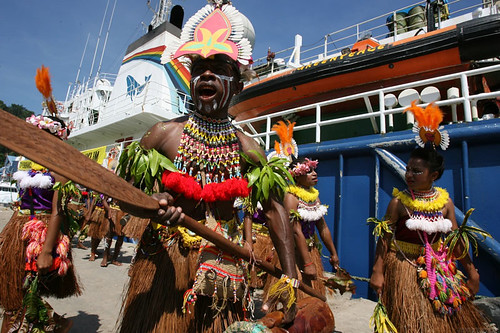 The Esperanza arrives in Jayapura, Indonesia, welcomed by a group of traditional Papuan dancers | |
| Read more about the Esperanza's arrival into Jayapura... Read how Dorothy, on board campaigner from Papua New Guina, met some of her Indonesian relatives for the first time... Listen to interviews with organisations working to protect the rights of forest-dwelling indigenous Papuans... | |
© 2008 Greenpeace |
Más sobre October 6 2008: Jayapura, Indonesia
1: October 9 2008: Papuan coast, Indonesia
Surveying the forests of Papua and West Papua | |
| One of the main purposes of the Forests For Climate ship tour is to head out and assess the current state of the forest. We will document the areas of forest that are still untouched, as well as the industries - such as industrial logging and palm oil plantations - which pose a threat to their continued existance. To do this, we need to take to the air in Tweety the helicopter. Over the next two weeks, we will conduct several flyovers in different areas as we move west along the New Guinea coast. As the region's forests are still more or less intact, we expect to see huge areas of beautiful forest stretching across the swampy coastal plains and the jagged mountains. But it's certain we'll also see evidence of logging and areas which have been converted into oil palm plantations. | |
| Take action! Write to the Indonesian president and tell him to protect the forests and save our climate | |
Papua: Indonesia's Last Forest Frontier | |
© 2008 Greenpeace |
Más sobre October 9 2008: Papuan coast, Indonesia
2: October 10 2008: Mamberamo River, Papua, Indonesia
The Mamberamo River | |
| Passing over some of the jagged foothills, all draped in heavy foliage, we hit the Mamberamo River which snaked, fat and brown, to the coast. Around one of the bends we found a logging camp where felled trees were being loaded on to a barge to ship downriver. Small areas nearby had been cleared of trees and while it was nothing like the large operation Bustar saw on Tuesday, it was a depressing reminder that loggers are starting to move into this area. We circled the camp a few times to take some pictures, flew out low over the river and then on to the Mamberamo Foja protected area where warm updrafts brought a damp, peaty, mushroom smell from beneath the canopy. It’s here that, in 2005, a team of scientists discovered several new species and looking down at the wealth of life rushing by beneath me, it’s almost certain that other plants and animals new to science are waiting to be discovered. If the chainsaws and oil palms don’t get there first. | |
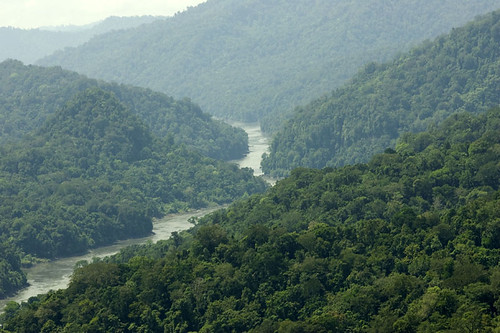 The Mamberamo River, the largest river in Papua, runs through areas of dense rainforest. | |
| Read more about Jamie's helicopter trip... | |
© 2008 Greenpeace |
Más sobre October 10 2008: Mamberamo River, Papua, Indonesia
3: October 13 2008: Kaimana, West Papua, Indonesia
Illegal logging exposed in Kaimana, West Papua | |
| We’ve already seen some incursions into the forests of Papua and West Papua, mainly logging roads and small camps but also deforestation on a much larger scale near Jayapura, at the hands of palm oil producer Sinar Mas. Then today our helicopter team discovered illegal logging was in progress. The team passed over the Kaimana area in West Papua where two logging companies had previously been operating, but had their permits suspended earlier this year. In July, the Indonesian police arrested senior executives of both companies - PT Centrico and PT Kaltim Hutama - for violating national forestry laws by logging outside the areas set in their permits. With all permits for this area currently suspended, there should be no logging activities of any kind, and yet logs were being loaded onto a barge to be transported downriver. And they were merbau logs, a highly vulnerable species of hardwood that also fetches a high price. | |
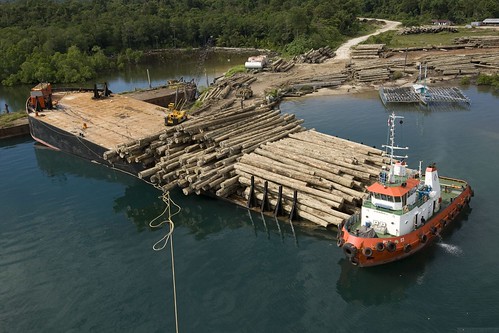 Merbau logs being loaded onto a barge in Kaimana, West Papua | |
| Read more about the discovery... | |
© 2008 Greenpeace |
Más sobre October 13 2008: Kaimana, West Papua, Indonesia
4: October 15 2008: Teluk Cenderawasih, West Papua, Indonesia
Does money grow on trees? | |
| We’ve now crossed the administrative border between Papua and West Papua and we’ve been anchored on the west side of Teluk Cenderawasih, a large bay which cuts into the Indonesian half of New Guinea, helping to create the distinctive 'bird’s head' feature. On the other side of the isthmus - the 'bird’s neck' - is Teluk Bituni and the largest mangrove area in south-east Asia. Here, the helicopter crew surveyed an oil palm plantation where, although it is still being farmed, it doesn’t look like there are currently any attempts to expand into the surrounding forest. That’s good news, but how do we make sure the forest remains intact? Even if a protected area was created to cover every square inch of forest, there is not enough money or resources to properly enforce that protection and make sure no one sneaks in to start up a logging operation. The solution is to make the rich countries of the world help fund the protection of forests, not just in Indonesia but also in the Amazon and the Congo basin. It's something Greenpeace has done a lot of work on and part of our work on this ship tour is to promote the Forests For Climate plan - a funding mechanism that will provide incentives to protect the world's forests, preserving the biodiversity and making sure the rights of forest-dwelling people are respected. | |
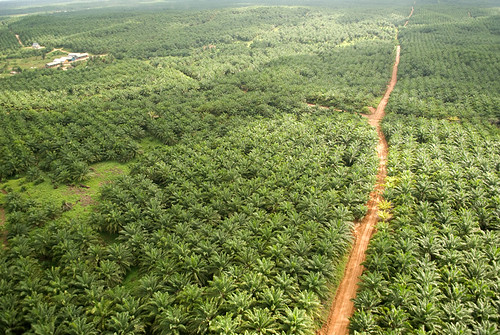 Oil palms where the forest used to be in West Papua, Indonesia. | |
| Read more about our Forests For Climate plan... Take action! Write to the Indonesian president and tell him to protect the forests and save our climate | |
© 2008 Greenpeace |
Más sobre October 15 2008: Teluk Cenderawasih, West Papua, Indonesia
5: October 17 2008: Manokwari, West Papua, Indonesia
Manokwari, here we come | |
| From our blog: After nine days at sea, the Esperanza pulled into Manokwari harbour this morning. Crowds of people were already on the dock and despite the overcast skies, we received one of the colourful and exotic welcomes I’m becoming accustomed to on this trip, with traditional dancing and singing to greet us when we disembarked. Manokwari isn’t what I expected. The image I had in my head was a quite an industrial place with lots of concrete, but although I haven’t left the port yet it looks very pleasant. It’s a small place, strung out along a bay and from the ship, most of the town is concealed by palms and trees. And just behind the town lies the forest, the tall tropical trees towering over the nearby buildings. Maybe it’s the proximity to the forest that gives the people of Manokwari the commitment to protect it, at least that’s the impression I got from those gathered on the dockside. People spontaneously shook my hand, although maybe they were just being friendly rather than responding to the Greenpeace t-shirt I was wearing. | |
 The dance party from the welcome ceremony in Manokwari take a tour of the Esperanza's bridge | |
| Read more about the arrival in Manokwari... Read about Valeriy's impromptu first aid clinic... Take action! Write to the Indonesian president and tell him to protect the forests and save our climate | |
© 2008 Greenpeace |
Más sobre October 17 2008: Manokwari, West Papua, Indonesia
6: October 21 2008: Halmahera Sea, Indonesia
Thar she blows | |
| While we were working, Locky the bosun and Silas spotted a commotion in the water a couple of hundred metres away. Areas of the sea were foaming, and every so often a plume of water would shoot skywards which could only mean one thing - whales. Several of them appeared to be herding schools of fish into bait balls and occasionally a set of massive jaws breached the water as a whale scooped up it's prey. Dimitri, our second mate, took a few photos and although we were some distance away, you can clearly see a whale gorging itself. It's seven years since he's seen a whale at sea - a lucky day, indeed. | |
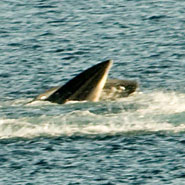 A whale feeding in the Halmahera Sea | |
| Take action! Write to the Indonesian president and tell him to protect the forests and save our climate | |
© 2008 Greenpeace |
Más sobre October 21 2008: Halmahera Sea, Indonesia
7: October 24 2008: Flores Sea, Indonesia
Investigating Indonesia's Last Forest Frontier | |
| With New Guinea now several days behind us, it's worth looking back over what we've seen since we arrived in Jayapura. Looking back over the footage and images from the helicopter flights over Papua and West Papua, there's still a great deal of relatively untouched forest on the island. But it's clear that threats from industrial logging and the expansion of palm oil plantations are ever-present, and in some regions we've witnessed extensive clearance of the forest. Watch the video below to see some of the most dramatic footage from the flights, narrated by our on board campaigner Bustar. | |
| Take action! Write to the Indonesian president and tell him to protect the forests and save our climate Read more about the ship tour on our blog... | |
Investigating Indonesia's Final Forest Frontier | |
© 2008 Greenpeace |
Más sobre October 24 2008: Flores Sea, Indonesia
8: October 27 2008: Java Sea, Indonesia
Messing about in boats | |
| Learning how to handle the boats is essential for the smooth running of the ship, and when the Esperanza is anchored out in a harbour or at sea, they’re often used to ferry people to shore and without them we’d be rather cut off when we’re not docked. I was a bit naïve to think that boat training just involved driving them; of course, we have to get them in the water first and under the watchful eye of Sabrine the boat engineer, we spent several hours practising that before we even got close to getting wet. | |
 Sabine and Neils take the African Queen for a spin | |
| Read more about what happened during boat training... Take action! Write to the Indonesian president and tell him to protect the forests and save our climate | |
© 2008 Greenpeace |
Más sobre October 27 2008: Java Sea, Indonesia
9: October 31 2008: Jakarta, Java, Indonesia
Forests For Climate: the great tree protection scheme | |
| From our blog: Change is in the air today. We’re picking up several new crew members who are joining us for the journey to Sumatra and the peatlands of Riau province. As I’ve been escorting one or two of them around the Esperanza, I can’t help thinking back to when I first came on board barely more than three weeks ago. It’s odd to think that this ship which is now so familiar was once just as new to me as well. But the big event today was perhaps the lynchpin of the entire expedition. In the VIP room of the bustling passenger terminal at Tanjung Priok port in Jakarta, we presented our Forests For Climate plan to get money flowing from developed countries to fund forest protection in Indonesia, Brazil and elsewhere, with the eventual aim of zero deforestation across the globe. The event was jointly hosted with the Indonesian environment minister, Rachmat Witoelar who opened the meeting. “Climate change cannot be held back if we continue with business as usual,” he said, adding that he wanted Indonesia to move to a low carbon economy while at the same time solving the economic problems which forces large numbers of the population to live in poverty. | |
 The Esperanza berthed in Tanjung Priok port, Jakarta | |
| Read more about the Forests For Climate plan... Read about Dmitri's special guests on the Esperanza... Take action! Write to the Indonesian president and tell him to protect the forests and save our climate | |
© 2008 Greenpeace |
Más sobre October 31 2008: Jakarta, Java, Indonesia
10: November 5 2008: Sungai Pakning, Sumatra, Indonesia
Slash and burn in Sumatra | |
| We’ve arrived in Sungai Pakning, a small port on the coast of Riau in Sumatra, and the Esperanza is anchored in a wide, silty channel running between the mainland and two islands, Pulau Bengkalis and Pulau Padang. The soupy water flowing gently past the ship will be down to the Siak river, the mouth of which is just a few miles south. Sungai Pakning might be small, but the signs of what’s happening further inland are everywhere. Large container ships wait patiently at anchor for their cargoes and the flame at the top of a refinery lights up the night sky. For we’re on the edge of the great plantations which have come to dominate this area, both the oil palms we’ve seen so much of and, increasingly, acacia trees which are being harvested to be used as pulpwood and paper. Tweety has been heading out on further reconnaissance missions over the Kampar peninsula. It’s an area we’re particularly interested in because it has a large area of swampy forest which is still intact, and it was the scene of last year’s Forest Defenders Camp where dams were built and banners raised. Sadly, the news is not good. As you can see from the image below, bulldozers are clearing through some of the remaining areas of forest. Just picture it: a few days (or even hours) before our camera got there, that piece of land was covered in forest which had probably been there for thousands of years. Now it’s gone, taking with it the wildlife and vegetation it harboured, and removing any possibility that local communities might be able to sustain themselves. It was happening while the helicopter flew past, and it’s still happening as you read this. | |
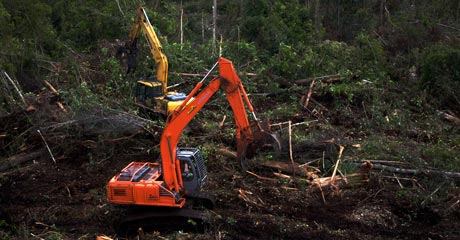 Bulldozers clear through peatland forest in a Duta Palma concession area | |
| Read more about the plantations of Riau... Read more about the Forest Defenders Camp... Take action! Write to the Indonesian president and tell him to protect the forests and save our climate | |
© 2008 Greenpeace |
Más sobre November 5 2008: Sungai Pakning, Sumatra, Indonesia
11: November 7 2008: Kampar Peninsula, Sumatra, Indonesia
Alongside the forest, up against the wall | |
| From our blog: I've scrubbed and showered but there are still traces of mud sticking to me. It's my own fault - I guess I shouldn't have gone tramping around the peatlands here in Riau. But the picture above, that's us: some of the Esperanza's crew and several Indonesian volunteers pulling our banner tight against the forest wall, the straight line that separates the thriving ecosystem from the barren areas which have been cleared of trees. In case you're wondering, I'm at the top of the P in 'STOP'. It was an early start and a long drive to get to the site on the Kampar peninsula, chosen because PT Arara Abadi-Siak has permits to set up plantations for acacia trees, used for making pulpwood and paper. The company is a subsidiary of Asia Pulp and Paper (APP), which is in turn owned by our old friends Sinar Mas - as well as having fingers in pulpwood, Sinar Mas is also one of the largest palm oil producers in Indonesia (not to mention a member of the Roundtable on Sustainable Palm Oil), and many of the nearby palm oil plantations have their name above the gate. The chosen spot was a few hundred metres from the dusty, potholed road so we had to clamber over some rough terrain to get there. Dead tree stumps and rutted ground lay in our path, not to mention the swampy bogs I fell into more than once. By the time we'd finished, most of us were covered up to our knees and beyond in thick black mud. Amongst all this, acacia saplings were growing in place of the forest that once stood there. | |
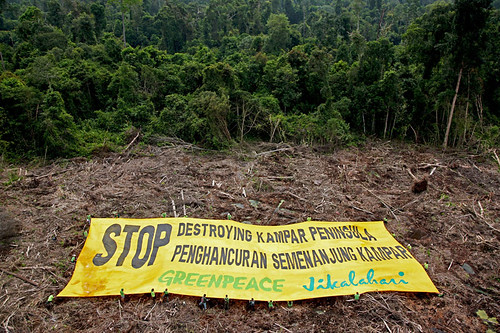 Greenpeace volunteers hold a banner in a deforested area of the Kampar peninsula | |
| Read more about unfurling the banner... Take action! Write to the Indonesian president and tell him to protect the forests and save our climate | |
© 2008 Greenpeace |
Más sobre November 7 2008: Kampar Peninsula, Sumatra, Indonesia
12: November 10 2008: Dumai, Sumatra, Indonesia
A new coat of paint for the palm oil ships | |
| From our blog: Another dawn start today and even though it’s barely mid-morning as I type this, we’ve already been out into Dumai harbour and tagged three ships with environmental slogans. They’re loaded with palm oil from the plantations of Riau, just like the ones we’ve seen from the air and from the ground over the past few days, so being daubed with ‘Forest Crime’ and ‘Climate Crime’ in bright yellow paint is only appropriate. The first stop on our tour of the port was the Gran Couva, a large tanker carrying 27,000 metric tonnes for palm oil giant Wilmar and bound for Rotterdam in the Netherlands. The two painting teams got off to a great start, marking out the positions of the letters and getting stuck into ‘Crime’. Angry shouts from the Gran Couva’s crew did nothing to dissuade the painters, and neither did the hoses which were turned on them. Unfortunately, the water-based paint didn’t last so well and some of the letters began to run. The first stop on our tour of the port was the Gran Couva, a large tanker carrying 27,000 metric tonnes for palm oil giant Wilmar (the same company that owns the plantations John flew over on Saturday) and bound for Rotterdam in the Netherlands. The two painting teams got off to a great start, marking out the positions of the letters and getting stuck into ‘Crime’. Angry shouts from the Gran Couva’s crew did nothing to dissuade the painters, and neither did the hoses which were turned on them. Unfortunately, the water-based paint didn’t last so well and some of the letters began to run. | |
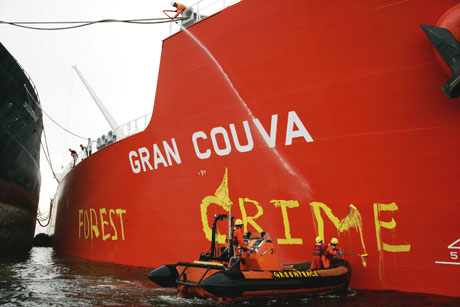 Painting the Gran Couva, loaded with palm oil from Wilmar | |
| Read more about painting the ships... Take action! Write to the Indonesian president and tell him to protect the forests and save our climate | |
© 2008 Greenpeace |
Más sobre November 10 2008: Dumai, Sumatra, Indonesia
13: November 11 2008: Dumai, Sumatra, Indonesia
It only takes one person to stop a giant palm oil tanker | |
| From our blog: We stepped up our game in Dumai and returned to the scene of our first paint job: the Gran Couva. After going back to the Esperanza for a break, some boat cleaning and a spot of lunch (who says direct action can’t be civilised?), a team returned to the palm oil tanker but this time the action hinges on just one person, attached to the Gran Couva’s anchor chain. A Greenpeace climber made his way up the chain and positioned himself so they couldn’t lift the anchor. This means the ship can’t leave the port and this will cause considerable inconvenience to Wilmar, the company that owns the cargo of palm oil. As the occupation carried on overnight and into the following day, the harbour master called our captain and asked if the man on the anchor chain would kindly move to a different ship. You can listen to the conversation below. | |
| Read more about the anchor chain occupation... Read about how the occupation ended... Take action! Write to the Indonesian president and tell him to protect the forests and save our climate | |
Listen to a discussion over the Esperanza's radio about whether the climber would kindly move to a different ship | |
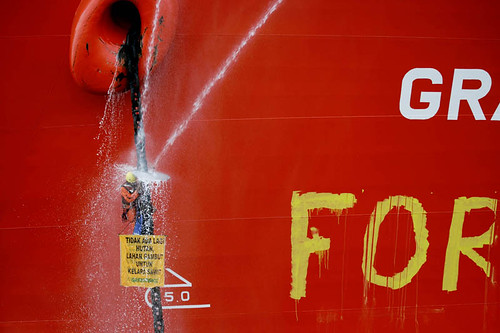 A Greenpeace climber hangs on to the anchor chain of palm oil tanker Gran Couva, braving water hoses used by the crew | |
© 2008 Greenpeace |
Más sobre November 11 2008: Dumai, Sumatra, Indonesia
14: November 14 2008: Dumai, Sumatra, Indonesia
Ship-to-ship blockade becomes a tug of war | |
| There’s one part of the quayside here in Dumai dedicated to piping palm oil into the bellies of the tankers. When a berth became free, the Esperanza moved in to occupy the space and so prevent a giant tanker, the Isola Corallo, from docking and collecting its cargo of crude palm oil. The port authorities maneuvered various tugs and barges and, if the blockade was to continue, the Esperanza was forced to attempt a move along the dock. Two tugs were waiting to push the ship and prevent it returning to the dock, and as the Corallo steamed in towards the berth, it became a nail-biting skill and ship-steering. Eventually, the tugs won out and the Esperanza was unable to continue the blockade but teams headed back to the Corallo to paint 'Forest Crime' and 'Climate Crime' slogans along its hull. | |
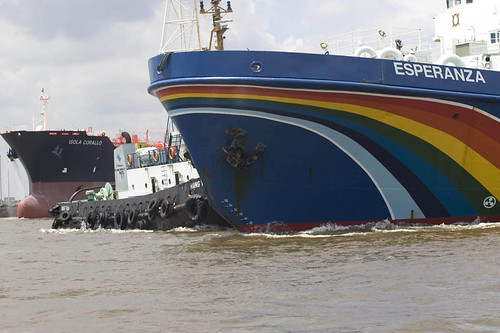 The Esperanza attempts to slip past a tug as the Isola Corallo comes in to dock © Greenpeace/Rante | |
| Read more about the blockade... Read more about how the action ended... Take action! Write to the Indonesian president and tell him to protect the forests and save our climate | |
© 2008 Greenpeace |
Más sobre November 14 2008: Dumai, Sumatra, Indonesia
15: November 17 2008: Singapore
Palm oil giant destroying national park in Borneo | |
| From our blog: The Esperanza is now anchored in Singapore harbour and there will be a few days of ship operations - taking on supplies and fuel, doing essential maintenance, that kind of thing. But all that’s happening without me. I disembarked yesterday and I’m finishing off a few things from a hotel in Little India. After weeks of daily cleaning chores, I have the strange urge to grapple a mop but I think the hotel staff would be bemused to say the least. I mentioned that there was one final task left to do, however, and that’s to expose once more the environmental crimes of Sinar Mas. Across the South China Sea from here in Kalimantan on the island of Borneo, Sinar Mas companies are clearing forests around the Danau Sentarum National Park, a wetland area protected under the international Ramsar convention, in order to expand their palm oil operations. The buffer zone which is being logged is vital to the health and biodiversity of the park, one of south-east Asia’s largest wetland areas and home to a wide range of species including clouded leopards, orang-utans and a large population of proboscis monkeys. According to reports in the Indonesian press, in August the Indonesian forest ministry revoked the permits of 12 companies operating in the area, seven of which belong to Sinar Mas. The loggers were breaching national conservation and biodiversity laws, but despite having its permits removed, Sinar Mas is still clearing forests around the park, showing a blatant disregard for Indonesian law and international conservation agreements. Sinar Mas is of course the same company behind the palm oil shipment we blocked in Dumai last week. | |
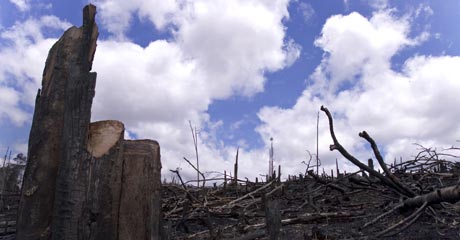 Burnt forest: the result of Sinar Mas' operations in Kalimantan | |
| Read more about the destruction of Kalimantan's national park... Take action! Write to the Indonesian president and tell him to protect the forests and save our climate | |
© 2008 Greenpeace |
Más sobre November 17 2008: Singapore